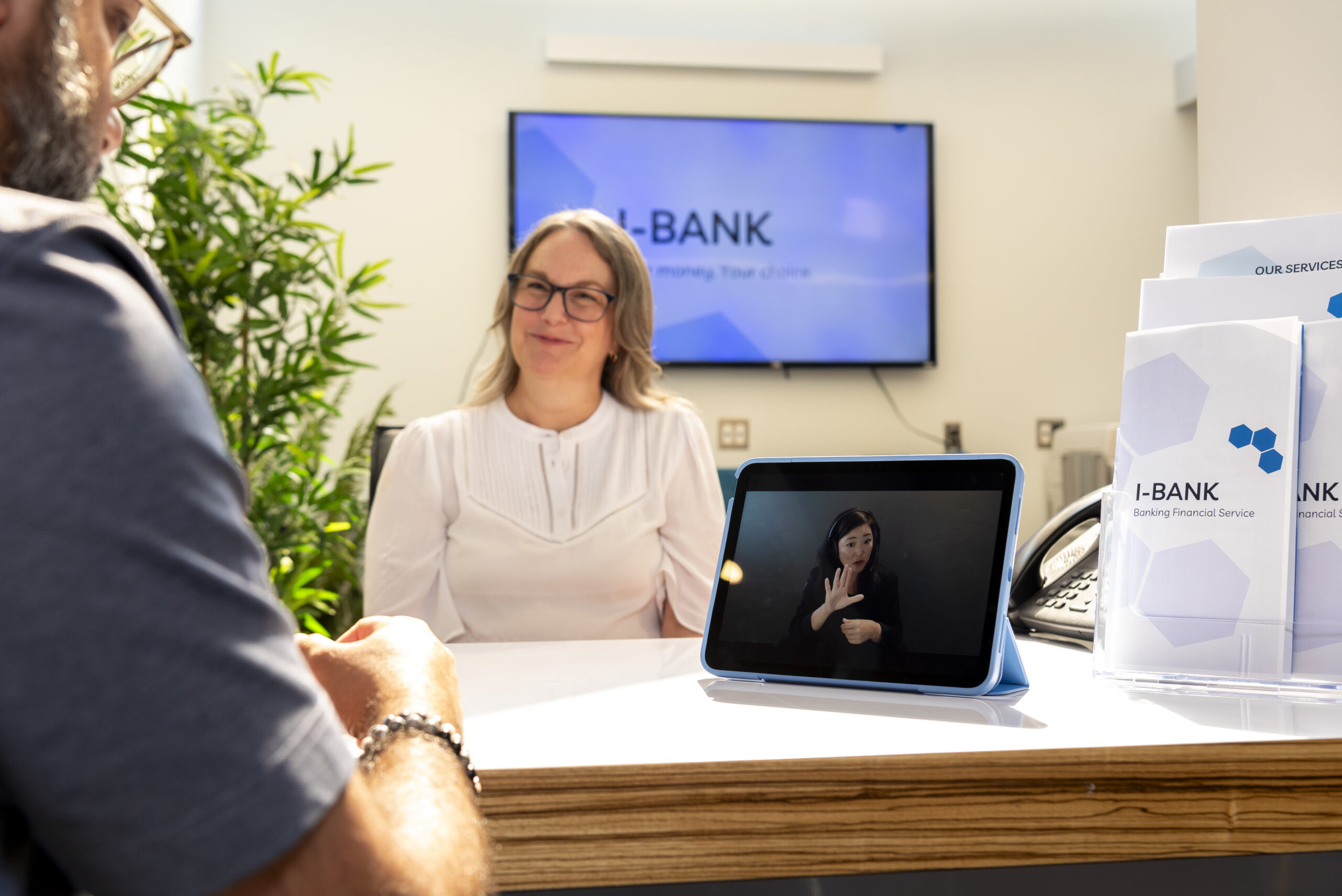With a staggering $82.2 billion in combined disposable income, Canadians with disabilities represent a powerful, underserved market for the banking sector. Yet, most banks don’t deliver fully accessible experiences, limiting their ability to compete in a diverse marketplace. True accessibility goes beyond wheelchair ramps and large-print brochures. It means creating a seamless customer experience where all clients feel recognized and understood.
Accessibility sends a powerful message to clients with disabilities: “You’re valued, you belong.”
This blog will explore why accessibility is essential for banks and other financial institutions. You’ll learn how the financial sector can better accommodate various disability groups, with a focus on the Deaf and hard of hearing community.
Understanding the Business Case for Accessibility
The Impact of Accessibility on Client Experience
There are two pillars to success in the Canadian banking sector: trust and client experience. Trust attracts your clients to open their first account, but once it’s earned, you must create an ideal client experience that fosters loyalty and retention—the key driver of revenue growth.
So how can you ensure that your bank is creating an ideal client experience for all Canadians? Start by recognizing that the disability community—and the 8 million Canadians within it—make up a substantial portion of your client base. Accessibility in the Canadian banking sector is not a “nice-to-have”, but a necessity for creating a positive client experience for everyone. Consider accessibility at all three stages of the client journey:
1. Awareness & Consideration
When choosing a bank, clients with disabilities ask questions like “Is this bank’s website easy to navigate?” “Does this bank have a reputation for being inclusive?” “Will I receive good service here?” All clients require clear, accessible information to make informed financial decisions.
2. Decision & Service
People with disabilities say that between 75-80% of their customer experiences are failures. Barriers—whether physical, digital, or attitudinal—signal that their business is not valued, leading them to take their money elsewhere.
3. Loyalty & Retention
People remember how you make them feel. Were they respected and treated as an equal? Were their needs addressed promptly or was banking with a disability a frustrating, drawn-out ordeal? Accessibility creates positive experiences that foster loyalty, while a lack of it drives clients away.
Simply put, if your bank does not meet the needs of Canadians with disabilities, they’ll find one that does. It’s not the client’s job to adapt, it’s your responsibility to ensure every client has a seamless banking experience.

Legal and Ethical Considerations for Accessibility in Banking
Accessibility is not just a strategic business decision–it’s a legal obligation. Under Canadian law, banks must act in accordance with the Canadian Human Rights Act (CHRA) and the Accessible Canada Act (ACA).
The CHRA prohibits discrimination and requires banks to provide equal treatment when delivering products and services to clients with a disability. Non-compliance can result in mandatory corrective actions, fines of up to $50,000, and the obligation to compensate victims of discrimination which can cost $20,000 – $40,000 more.
The ACA, adopted in 2019, aims to make Canada barrier-free by 2040. Under this law, banks and other federally mandated organizations are required to identify and eliminate barriers in areas such as digital accessibility and communication. To accommodate the Deaf and signing community, banks should offer sign language interpretation.
According to the ACA, the primary languages of Deaf people in Canada are American Sign Language (ASL) and Langue des signes québécoise (LSQ). English and French are often second—or even third or fourth languages for Deaf individuals.
Violations of the ACA can lead to inspections, compliance orders, and fines of up to $250,000 per offense. Beyond fines, failing to prioritize accessibility can expose your company to lawsuits and reputational damage. Accessibility-related lawsuits, especially concerning digital access, are on the rise—and they’re expensive to settle. Additionally, addressing accessibility complaints demands significant operational resources which contributes to higher overall costs. Accessibility issues are expensive, and more importantly, avoidable.
According to Statistics Canada and the Canadian Association of the Deaf, about 5–10% of Canadians belong to this community. Still, banks often overlook the unique communication needs of Deaf clients.
Key Considerations for Building Accessibility in Banking
Understanding the Needs of Deaf Clients
Making banking services accessible begins with understanding the needs of various disability groups, including Deaf and hard of hearing clients. According to Statistics Canada and the Canadian Association of the Deaf, about 5-10% of Canadians belong to this community. Still, banks often overlook the unique communication needs of Deaf clients.
To address these needs, your bank must provide the following:
- Canadian interpreters who are familiar with Canada’s financial landscape and various provincial dialects including ASL and LSQ. Interpreters based in the US may not know the terminology or programs relevant to Canada, creating a frustrating customer experience for Deaf clients.
- Immediate access to interpreters. Deaf clients shouldn’t have to plan ahead for their visits. They deserve the same access as hearing clients.
- Trained staff who understand how to effectively accommodate and serve Deaf clients.
- Websites and other digital content translated into sign language.
- An explanation of your accommodations and accessibility-related information for Deaf clients.
Implementing Technology Solutions for Accessibility for Deaf Clients
When implementing accessibility solutions, it’s important to treat people as individuals, recognizing that one-size-fits-all accommodations won’t work for everyone. Deafness exists on a spectrum—people experience different levels of hearing loss and use a variety of communication methods.
We spoke with Jennifer Jahnke, a digital accessibility consultant and Principal Educator at AccessibilityConsulting.ca, about the technology solutions available for the Deaf community. Jennifer recommended Video Remote Interpreting (VRI) as a vital tool for banks to ensure equitable service for Deaf clients. VRI connects Deaf and hearing individuals with a virtual sign language interpreter in real time, eliminating communication barriers. VRI users can connect either on-site at the branch or virtually, but the interpreter is always remote. This eliminates travel costs and potential delays associated with hiring an in-person interpreter.
VRI can be scheduled in advance or accessed on-demand. With VRI On-Demand, clients can reach an interpreter within minutes via a mobile device, tablet or laptop. No appointment is necessary. Whether a client is making a quick, unplanned visit, opening a new account, or applying for a loan, VRI On-Demand ensures you can provide immediate, top-quality service. Financial conversations can be complex…make them easier with Video Remote Interpreting (VRI) On-Demand.
In addition to VRI On-Demand, Jennifer recommended the following technologies:
- Video Relay Service (VRS): This is a government-funded service that allows Deaf, hard of hearing, or speech-impaired Canadians to make phone calls through a relay interpreter. Banks should provide dedicated VRS numbers and adequate employee training to ensure VRS calls are not mistakenly rejected.
- Translation: Converts your finalized text or video content from English to American Sign Language (ASL) and from French to Quebec Sign Language (LSQ). Translation is an effective way to enhance your website’s accessibility—a topic we’ll cover in depth in the digital accessibility section of this blog.
- Real-Time Captioning: Apps like Google Live Transcribe and Ava provide real-time speech-to-text transcription and allow Deaf individuals to follow conversations as they happen.
- Instant Messaging: Allows Deaf individuals to communicate through text for quick, informal inquiries. With a VRI On-Demand subscription, you can integrate VRI into your website’s chat bot.
While real-time captioning and instant messaging are helpful tools for those proficient in English or French, they are not substitutes for sign language interpreting.
Training and Education for Bank Staff on Accessibility for the Deaf Community
Equity, Diversity and Inclusion (EDI) training is becoming increasingly common, but the Deaf community is often overlooked or insufficiently addressed in these sessions, leaving bank staff unprepared to effectively serve Deaf clients.
The Canadian Association of the Deaf interviewed one of the two licensed Deaf financial advisors in Canada to understand financial service barriers for the Deaf community. According to the advisor, in the absence of sign language interpreters, banks inadvertently select overly conservative investment options for Deaf clients, which limits their financial growth. That’s why proper training is so important.
So, what should this training entail?
- An overview of relevant legislation and why accessibility is a legal and ethical obligation.
- Universal design principles (which we’ll discuss later) that highlight the importance of making services accessible to everyone.
- Deaf culture and appropriate language. For example, terms like “hearing impaired” are outdated and offensive.
- Avoiding harmful assumptions, eliminating stereotypes, and practicing non-discriminatory behavior.
- Using tools like VRI On-Demand, captioning, and transcript features effectively.
- The dos and don’ts of working with interpreters.
In tandem with training, your bank must establish and enforce strong accessibility policies. These policies should clearly define accessibility standards, how to access available accommodations, and contingency plans for employees to follow if these services are unavailable.

The Benefits of Accessibility in Banking
Increased Client Loyalty and Retention
Increasing client retention rates will have a direct impact on your bank’s profitability. Loyal clients have a higher lifetime value, offer opportunities for cross-selling and up-selling, and are more cost-effective to retain than acquiring new clients.
Yet, the latest banking customer retention statistics reveal:
- 56% of customers who leave a bank say their bank made no effort to retain them.
- Nearly half of the customers who leave banks do so in the first 90 days after opening an account.
- 86% of banking customers will pay more for a better client experience.
The message is clear: banks must provide a superior customer experience to retain their clients. For clients with disabilities, accessibility is the key to delivering this experience. Providing accommodations, such as Video Remote Interpreting (VRI) for Deaf clients, shows a genuine effort to meet their needs, thus reducing the risk of them switching to a competitor. Accessibility is not just a compliance requirement—it’s a competitive advantage.
Tapping into an Underserved Market
According to the 2020 Annual Report by Return on Disability, Canadians with disabilities have a combined disposable income of $82.2 billion. People with disabilities also influence the purchasing decisions of their friends and family, who witness the daily barriers their loved one’s face when accessing essential services. The friends and family members of Canadians with disabilities is estimated to be 17 million people, adding $538.5 billion onto that disposable income—an opportunity no bank can afford to ignore.
Increased Brand Value and Reputation
Brand perception is critical, as many customers choose companies that align with their values. By embracing accessibility, your brand appeals to everyone who prioritizes equity and social responsibility, not just those with a disability.
A bank with an inclusive brand image also attracts a diverse range of talent. Employees with disabilities bring unique innovation, adaptability and problem-solving skills to your workforce. Their lived experiences can help your bank design better products, services and policies that cater to all types of clients and improve your overall service offering.
Universal Design Creates Value for Everyone
Curb cuts at the end of sidewalks were initially designed for wheelchair access. Today, they benefit everyone—cyclists, parents with strollers, and people using crutches. That’s universal design. What was once intended solely for wheelchair users now serves a much wider community.
Similarly, addressing the needs of the Deaf community—such as incorporating closed captions into meetings and videos—also benefits a diverse range of banking clients. For instance, as Canada’s population ages, a larger number of older adults will experience hearing loss, making captions necessary for full comprehension. Captions also ensure that clients can watch your videos with no sound when in public spaces. By implementing inclusive features for the Deaf community, banks improve experiences for all clients.

Examples of Deaf Discrimination
Deaf discrimination, also known as audism, occurs when a Deaf individual is believed to be inferior or is treated less favourably because they are Deaf. Failing to accommodate is considered a form of audism. We interviewed Vinu Abraham Chetipurackal who shared his experience as a Deaf client trying to access essential banking services.
I was trying to build my investment portfolio and understand high versus low-risk investments, but the bank created a barrier to communicate freely about financial matters.
- Vinu Abraham Chetipurackal, customer
After being promised an interpreter for a scheduled appointment with his financial advisor, Vinu arrived to find none available. Instead, the bank suggested writing back and forth. This approach prevented him from asking detailed, nuanced questions in his first language, resulting in simple yes/no answers from his financial advisor. “I was trying to build my investment portfolio and understand high versus low-risk investments, but the bank created a barrier to communicate freely about financial matters.” Being told to “sign here” without fully understanding the financial risks associated with your investments is overwhelming and unfair.
Unfortunately, many Deaf Canadians face discrimination when trying to access banking services. Other examples of Deaf discrimination within the banking sector include:
- Telling a Deaf person to read lips instead of asking for their preferred communication method.
- Making decisions about Deaf clients’ banking needs, services, or financial advice without consulting the client themselves.
- New banking technologies, such as systems that rely exclusively on voice-activation, which prevent Deaf clients from accessing services.
- Excluding Deaf candidates during the recruitment and promotion process.
Accessibility Examples: Solutions for the Banking Sector
While we’ve been focusing on the needs of the Deaf and hard of hearing community, banks should implement strategies that cater to all disability groups. Below are a few examples of how banks can better serve other disability communities:
For clients with physical disabilities:
- Ensure all branches have ergonomic seating and accessible washrooms
- Optimize branch exteriors and entrances (e.g., parking spots, ramps, wave-to-open doors)
- Provide lower ATMs for wheelchair users
For the blind, deafblind, and/or low vision community:
- Provide braille, large print, and audio versions of client materials
- Add tactile features to debit/credit cards so clients can identify the card number
- Make bank statements and other PDFs accessible for assistive technology
- Enhance ATMs with bright colors, large-character keypads, audio support, and lights to guide users to the card and deposit slots
For clients with cognitive challenges:
- Use plain language, limit acronyms, and avoid long sentences or complex financial terms (when possible) that may be difficult to understand
- Regularly assess internal and external communication standards to ensure language used is simple, concise, and accessible to all clients
Your bank should consult with each community directly to identify their barriers and needs.
Key Considerations for Digital Accessibility
With the shift to online banking, clients expect websites and digital platforms to be highly functional and compliant with Web Content Accessibility Guidelines (WCAG). In fact, 75% of respondents with disabilities said they evaluate a bank’s online and mobile features when choosing a financial service provider.
What are Web Content Accessibility Guidelines (WCAG)?
WCAG is an internationally recognized standard aimed at making digital content accessible for all, including people with disabilities. WCAG’s guidelines define the steps that organizations must take to achieve different levels of accessibility, ranging from the lowest standard, Level A, to the highest standard, Level AAA.
WCAG Compliance for Canadian Banks in 2024
In 2024, under the Accessible Canada Act (ACA), federally regulated entities such as banks are required to meet WCAG 2.1 Level AA standards.
Banks should anticipate changes in legislation and implement new standards before they become mandatory. To compete globally, they must exceed Canada’s minimum requirements, as banks in countries like the UK are already required to meet higher WCAG standards than those in Canada.
- Jennifer Jahnke, digital accessibility consultant
The Future of WCAG in Canada
The ACA aims to align with European accessibility standards, keeping pace with global progress. Digital accessibility consultant, Jennifer Jahnke, advises banks to stay ahead of emerging digital accessibility standards. “Banks should anticipate changes in legislation and implement new standards before they become mandatory. To compete globally, they must exceed Canada’s minimum requirements, as banks in countries like the UK are already required to meet higher WCAG standards than those in Canada.” Translation, for example, is part of WCAG’s Level AAA and banks committed to accessibility for the Deaf community should have their website translated.
Digital Accessibility for the Deaf Community
For Deaf users, an accessible website has content translated into sign language, allowing the Deaf community to access information in their first language. This ensures they can better understand your products, services , and policies. Additionally, your website should have a dedicated webpage for Deaf and hard-of-hearing clients that outlines available accommodations and how to access them.

No Shortcut to Digital Accessibility
In an attempt to comply with WCAG, some organizations have opted for quick fixes like accessibility overlays. An accessibility overlay is a software tool you install on your website, allowing users to customize features such as contrast and font size. The problem is overlays make websites less adaptable, preventing people from using their own assistive technology. They override user preferences, disrupting screen readers and keyboard navigation. Many companies using accessibility overlays have had lawsuits filed against them for failing to comply with digital accessibility standards.
Build a Case for Accessibility
Now that you’ve explored the essential role accessibility plays in the Canadian banking sector, it’s time to use these insights to build the business case for accessibility at your bank. Which communities are still excluded from your services? What barriers can you identify at your branches? Is your website accessible for the Deaf community?
By making your bank accessible, you can avoid legal nightmares, and more importantly, create better client experiences, unlocking new business opportunities, and improving your reputation. Accessibility is the gateway to serving millions of Canadians with disabilities and their extended networks, driving customer loyalty, retention, and growth. By investing in accessibility, you are investing in the future of your bank and ensuring that every Canadian can access your services seamlessly.
If you’re still reading, this is your (A)sign to become accessible: www.asign.ca
Special Acknowledgment: Thank you to Vinu Abraham Chetipurackal and Jennifer Curry Jahnke for participating in interviews and sharing your knowledge and experiences with us. Your contributions are greatly appreciated!
Related Articles
Accessibility, Success Stories | Nov 28, 2025
Beyond Access: How On-Demand Interpreting Helped Unlock a Team Member’s Full Potential
Accessibility, VRI | Nov 19, 2024


